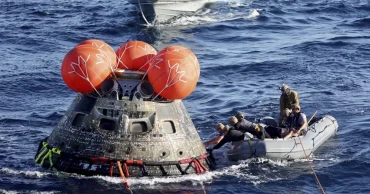Pacific
NASA Orion capsule safely blazes back from moon, aces test
NASA’s Orion capsule made a blisteringly fast return from the moon Sunday, parachuting into the Pacific off Mexico to conclude a test flight that should clear the way for astronauts on the next lunar flyby.
The incoming capsule hit the atmosphere at Mach 32, or 32 times the speed of sound, and endured reentry temperatures of 5,000 degrees Fahrenheit (2,760 degrees Celsius) before splashing down west of Baja California near Guadalupe Island. A Navy ship quickly moved in to recover the spacecraft and its silent occupants — three test dummies rigged with vibration sensors and radiation monitors.
NASA hailed the descent and splashdown as close to perfect, as congratulations poured in from Washington..
“I'm overwhelmed,” NASA Administrator Bill Nelson said from Mission Control in Houston. “This is an extraordinary day ... It's historic because we are now going back into space — deep space — with a new generation.”
Read more: NASA's Orion capsule reaches moon, last big step before lunar orbit
The space agency needed a successful splashdown to stay on track for the next Orion flight around the moon, targeted for 2024 with four astronauts who will be revealed early next year. That would be followed by a two-person lunar landing as early as 2025 and, ultimately, a sustainable moon base. The long-term plan would be to launch a Mars expedition by the late 2030s.
Astronauts last landed on the moon 50 years ago. After touching down on Dec. 11, 1972, Apollo 17′s Eugene Cernan and Harrison Schmitt spent three days exploring the valley of Taurus-Littrow, the longest stay of the Apollo era. They were the last of the 12 moonwalkers.
Orion was the first capsule to visit the moon since then, launching on NASA’s new mega moon rocket from Kennedy Space Center on Nov. 16. It was the first flight of NASA’s new Artemis moon program, named after Apollo’s mythological twin sister.
“From Tranquility Base to Taurus-Littrow to the tranquil waters of the Pacific, the latest chapter of NASA’s journey to the moon comes to a close. Orion back on Earth,” announced Mission Control commentator Rob Navias.
While no one was on the $4 billion test flight, NASA managers were thrilled to pull off the dress rehearsal, especially after so many years of flight delays and busted budgets. Fuel leaks and hurricanes conspired for additional postponements in late summer and fall.
In an Apollo throwback, NASA held a splashdown party at Houston’s Johnson Space Center on Sunday, with employees and their families gathering to watch the broadcast of Orion’s homecoming. Next door, the visitor center threw a bash for the public.
Getting Orion back intact after the 25-day flight was NASA’s top objective. With a return speed of 25,000 mph (40,000 kph) — considerably faster than coming in from low-Earth orbit — the capsule used a new, advanced heat shield never tested before in spaceflight. To reduce the gravity or G loads, it dipped into the atmosphere and briefly skipped out, also helping to pinpoint the splashdown area.
Read more: NASA’s newest moon rocket lifts off 50 years after Apollo
All that unfolded in spectacular fashion, officials noted, allowing for Orion’s safe return.
“I don't think any one of us could have imagined a mission this successful," said mission manager Mike Sarafin.
Further inspections will be conducted once Orion is back at Kennedy by month’s end. If the capsule checks find nothing amiss, NASA will announce the first lunar crew amid considerable hoopla in early 2023, picking from among the 42 active U.S. astronauts stationed at Houston’s Johnson Space Center.
“People are anxious, we know that,” Vanessa Wyche, Johnson's director, told reporters. Added Nelson: “The American people, just like (with) the original seven astronauts in the Mercury days, are going to want to know about these astronauts.”
The capsule splashed down more than 300 miles (482 kilometers) south of the original target zone. Forecasts calling for choppy seas and high wind off the Southern California coast prompted NASA to switch the location.
Orion logged 1.4 million miles (2.25 million kilometers) as it zoomed to the moon and then entered a wide, swooping orbit for nearly a week before heading home.
It came within 80 miles (130 kilometers) of the moon twice. At its farthest, the capsule was more than 268,000 miles (430,000 kilometers) from Earth.
Orion beamed back stunning photos of not only the gray, pitted moon, but also the home planet. As a parting shot, the capsule revealed a crescent Earth — Earthrise — that left the mission team speechless.
Nottingham Trent University astronomer Daniel Brown said the flight's many accomplishments illustrate NASA's capability to put astronauts on the next Artemis moonshot.
“This was the nail-biting end of an amazing and important journey for NASA’s Orion spacecraft," Brown said in a statement from England.
The moon has never been hotter. Just hours earlier Sunday, a spacecraft rocketed toward the moon from Cape Canaveral. The lunar lander belongs to ispace, a Tokyo company intent on developing an economy up there. Two U.S. companies, meanwhile, have lunar landers launching early next year.
3 years ago
Need for all nations to respect maritime democracy: US Pacific fleet commander
Admiral Samuel J Paparao, Commander of US Pacific Fleet, on Sunday emphasized the need for all nations to respect maritime democracy, international rules-based order and concepts of the sovereignty of freedom of seas because these all are in the interest of all the nations.
Speaking to media persons on the sidelines of the MILAN multinational exercise in Visakhapatnam, he said, "This MILAN conference has also emphasised on QUAD discussions between the United States, India Japan and Australia. The QUAD is a shining example when we talk about great maritime powers such as Japan, India, Australia and the United States."
READ: Joint exercise of BAF, US Pacific Air Force ends
Admiral Paparao, who was in Visakhapatnam to participate in the eleventh edition of MILAN being hosted by Eastern Naval Command, said that the future is bright with regard to the building of the interoperability between Indian and American forces as they move forward with greater and greater sharing of network and technologies.
He also said that the United States and India are actively sharing defence technologies such MH60 Romeo choppers.
The admiral said, "Alliances have responsibilities to one another within the alliance and in QUAD nations we see the recognition of shared values and shared interest and commitments between countries to help each other."
Calling Vietnam's participation in MILAN inspiring, Admiral Paparao said it is "unfortunate" that Vietnam often has been the victim of aggression on its maritime domain in terms of bigger nations trying to make excessive claims on its exclusive economic zones.
"By participating in MILAN countries can form an alliance and seek each other's help and cooperation to deal with threats that they facing from some of the bigger nations," he added
Admiral Paparao on Saturday visited USS Fitzgerald, an Arleigh Burke-class destroyer in the US Navy, to meet the sailors on board. He thanked the sailor for the great job they have been doing to serve the United States in furthering its defence relations with India and other countries in the Indo-Pacific region.
READ: US Pacific commander says China seeks to intimidate region
USS Fitzgerald and a P-8A Poseidon maritime patrol and reconnaissance aircraft VP-47, joined with ships, aircraft and personnel from India and other navies to participate in the MILAN Exercise in Visakhapatnam.
Joel Reifman, U.S. Consul General in Hyderabad also participated in the MILAN. During his two-day stay in Visakhapatnam, Reifman visited USS Fitzgerald and met sailors. He also had meetings with several senior Indian naval officers.
The eleventh edition of MILAN is being hosted by the Eastern Naval Command at Vishakhapatnam for the first time. The participation from Friendly Foreign Countries includes 13 ships, 39 delegations and one Maritime Patrol Aircraft. This large congregation gives significance and potency to the word 'MILAN' which means "meeting" or "confluence" in Hindi. A Special Day Cover and a movie on the MILAN exercise was released by the Chief Guest to mark the occasion.
"MILAN endeavours to promote "Camaraderie, Cohesion, Collaboration" between like-minded Navies. This is achieved by professional interaction and experience sharing at the harbour and enhancing interoperability, including multilateral operations at sea", stated the Navy's official release.
The harbour phase of the exercise will culminate on February 28, followed by the sea phase from 1 March to 4 March.
3 years ago
Cosmic 2-for-1: Total lunar eclipse combines with supermoon
The first total lunar eclipse in more than two years coincides with a supermoon this week for quite a cosmic show.
This super “blood” moon will be visible Wednesday across the Pacific — offering the best viewing — as well as the western half of North America, bottom of South America and eastern Asia.
Better look quick: The total eclipse will last about 15 minutes as Earth passes directly between the moon and the sun. But the entire show will last five hours, as Earth’s shadow gradually covers the moon, then starts to ebb. The reddish-orange color is the result of all the sunrises and sunsets in Earth’s atmosphere projected onto the surface of the eclipsed moon.
“Hawaii has the best seat in the house and then short of that will be California and the Pacific Northwest,” said NASA’s Noah Petro, project scientist for the Lunar Reconnaissance Orbiter. New Zealand and Australia also will have prime viewing.
Read:Solar eclipse on the longest day of the year
Circling the moon for 12 years, the orbiter will measure temperatures changes on the lunar surface during the eclipse. Telescopes atop Hawaii’s Mauna Kea also will monitor the moon, Petro said.
The moon will be setting and the sun rising along the U.S. East Coast, leaving skygazers — Petro in Virginia included — pretty much out of luck. Europe, Africa and western Asia will miss everything. There will be livestreams available.
Everyone everywhere, though, can still soak in the brighter than usual moon, weather permitting.
The moon will be more than 220,000 miles (357,460 kilometers) away at its fullest. It’s this proximity, combined with a full moon, that qualifies it as a supermoon, making it appear slightly bigger and more brilliant in the sky.
Last month’s supermoon, by contrast, was 96 miles (155 kilometers) more distant.
Read: 2-for-1: Total lunar eclipse comes with supermoon bonus
Unlike a solar eclipse, there’s no harm in looking at an eclipsed moon.
More lunar shows are on the horizon.
“For people who might feel like we’re missing out, set your calendars for Nov. 19 of this year,” Petro said. This will be a nearly total eclipse where the moon dims but doesn’t turn red.
The next total lunar eclipse will be May 2022. The last one was January 2019.
4 years ago
Violence against women remains regional epidemic in Pacific
Suva, Oct 29 (Xinhua/UNB) -- Violence against women and girls remains a regional epidemic in the Pacific region, a Fijian government minister said on Tuesday.
6 years ago




